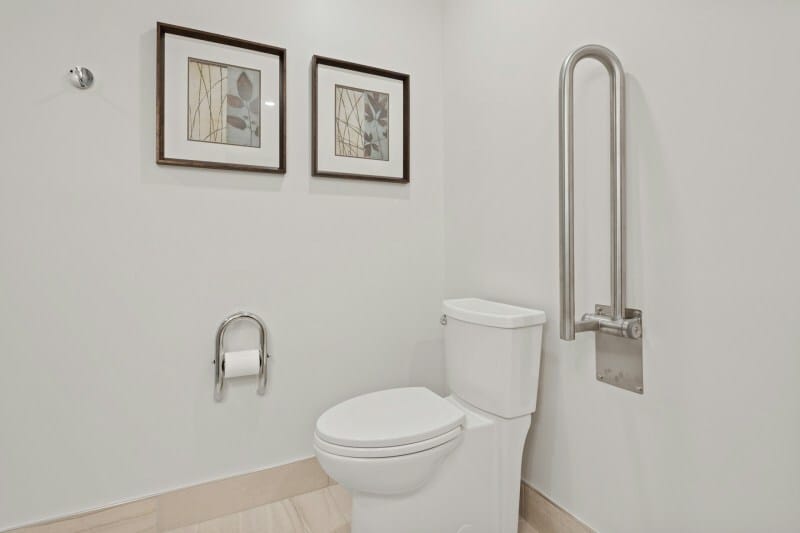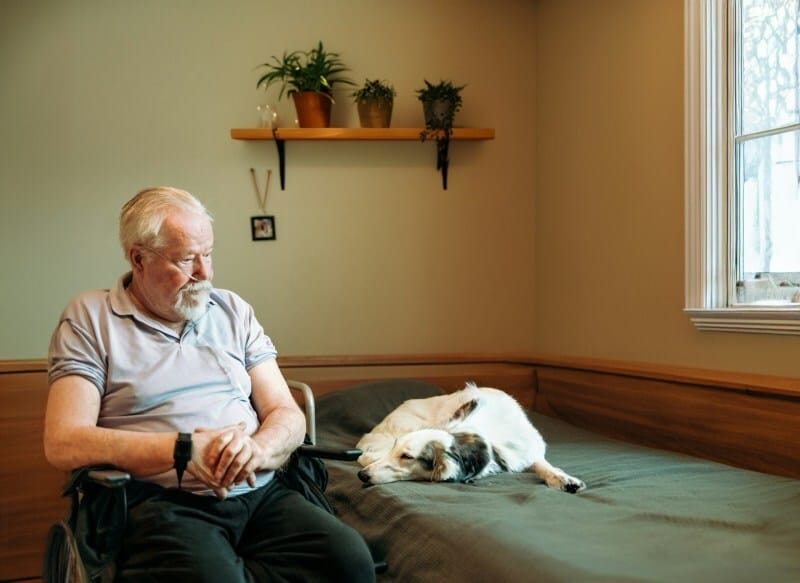Aging in place has become an increasingly popular choice for seniors who value independence and the comfort of staying in their own homes. However, as people age, their living spaces often fail to address the unique challenges that come with mobility changes, reduced balance, and the heightened risk of falls.
The consequences of these falls can be devastating, particularly for older adults who suffer injuries like hip fractures. In fact, the link between falls and broken hip mortality highlights just how critical it is to create safer living environments.
Yet, safety doesn’t have to come at the expense of beauty. With thoughtful design, it’s possible to create spaces that prioritize functionality while maintaining aesthetic appeal.This article explores how to blend safety and style, ensuring that homes are not only livable but also inspiring for seniors and their families.

Why Safety in Design Matters for Seniors
For seniors, the home can be both a sanctuary and a potential source of danger. As mobility decreases with age, seemingly minor design flaws—such as uneven floors, poor lighting, or slippery surfaces—can become serious hazards. According to studies, falls are the leading cause of injuries among older adults, often resulting in debilitating conditions like hip fractures. These injuries not only impact physical health but can also lead to social isolation, loss of independence, and significant financial strain.
The alarming statistics around broken hip mortality underscore the severity of such incidents. For many seniors, a broken hip marks the beginning of a decline in overall health, with complications such as infections or reduced mobility leading to life-threatening outcomes.
This makes proactive design crucial—not just to prevent falls but also to preserve the quality of life. A well-designed space can minimize risks while promoting confidence and ease of movement. Alongside structural safety upgrades, it’s also worth considering medical alert devices for Canadian seniors and also from other places, which provide immediate access to help in the event of a fall or emergency.
These systems can serve as a vital link between seniors and emergency support, offering peace of mind to both users and their families. By incorporating safety elements into every room—and layering in smart solutions like alert systems—homeowners can create environments that empower seniors to live comfortably and securely, no matter their age.

Key Principles of Senior-Friendly Design
Designing a home for aging in place goes beyond simply adding a few safety features. It’s about creating an environment that seamlessly integrates functionality, accessibility, and style, ensuring that seniors can move freely and comfortably without sacrificing aesthetics. The foundation of this approach lies in Universal Design—a concept that emphasizes spaces that are usable by people of all ages and abilities.
Slip-Resistant Flooring
Slippery floors are one of the most common culprits behind falls. Replacing smooth tiles with textured or non-slip materials can significantly reduce the risk of accidents, especially in high-risk areas like bathrooms and kitchens.
Adequate Lighting
Proper lighting is essential for seniors, as age-related vision changes can make it difficult to navigate dimly lit areas. Layered lighting solutions, including ambient, task, and accent lighting, can improve visibility while enhancing the home’s aesthetic.
Zero-Threshold Design
Thresholds and steps can be dangerous for those with limited mobility. By opting for zero-threshold showers, ramps, and flush floor transitions, homeowners can make movement easier while maintaining a sleek, modern look.
According to experts like the AARP, implementing Universal Design principles can help seniors maintain independence and prevent injuries without compromising the overall beauty of a space. These concepts ensure that homes are not only practical but also timeless in their appeal, accommodating the needs of aging residents and their families.
Ergonomic and Adjustable Fixtures
Lever-style door handles, touchless faucets, and adjustable countertops are small upgrades that make a big difference in accessibility. These features enhance usability for seniors while blending into modern design trends.
By incorporating these key principles, homeowners can create senior-friendly spaces that are both safe and stylish, enabling aging individuals to thrive in the comfort of their own homes.
Merging Safety and Aesthetics: Tips for Every Room
Creating a senior-friendly home doesn’t mean sacrificing style. With thoughtful choices, you can design spaces that prioritize safety while maintaining a sense of elegance and comfort. Here are room-by-room tips to achieve this balance:
Living Areas
The living room is often the heart of the home, making it a key focus for safety. Opt for furniture with rounded edges to prevent injuries from accidental bumps. Replace area rugs with large, non-slip rugs or secure them with double-sided tape to reduce tripping hazards. Choose seating with firm cushions and armrests, which make it easier for seniors to sit down and stand up.

Kitchens
Accessibility is paramount in the kitchen. Install cabinets and shelves at reachable heights to minimize the need for step stools. Soft-close drawers and pull-out shelves not only add a modern touch but also make it easier to access stored items. Use non-slip mats near the sink and stove, and ensure that flooring materials are water-resistant and textured for added safety.
Bathrooms
Bathrooms pose the greatest risk for falls, but they can be transformed into safe, spa-like retreats. Zero-threshold showers with handheld showerheads are both luxurious and practical. Stylish grab bars in finishes like brushed nickel or matte black can double as towel holders, blending safety with elegance. Install anti-slip tiles in complementary colors to add character to the space.
Outdoor Spaces
Nature-inspired spaces are soothing and promote well-being, but uneven ground and obstacles can pose risks. Level pathways made from textured stone or concrete can prevent slips, while raised garden beds make gardening more accessible. Install sturdy railings for stairs and ramps, and add motion-sensor lighting for better visibility after dark.
By addressing each area of the home with a focus on both form and function, you can create a cohesive environment that supports seniors’ needs without compromising on design. These tips prove that safety and style can go hand in hand, turning homes into safe havens that inspire comfort and beauty.
Real-Life Inspirations: Spaces That Do It Right
Around the world, designers are finding innovative ways to merge safety and aesthetics, creating environments that not only meet the functional needs of seniors but also elevate their quality of life. Here are some inspiring examples of senior-friendly spaces that balance beauty with practicality:
The Scandinavian Approach: Minimalism Meets Functionality
In Scandinavia, minimalism is a hallmark of design—and it’s particularly well-suited for aging-in-place homes. Clean lines, open layouts, and natural materials make spaces feel calm and uncluttered, reducing tripping hazards while creating a sense of spaciousness. Non-slip wood or vinyl flooring in soft, neutral tones adds warmth and safety, seamlessly blending into modern interiors.
Biophilic Design in Senior Living Communities
Biophilic design—an approach that incorporates elements of nature—has been shown to improve mental well-being and recovery rates. Some senior living communities have embraced this concept by integrating indoor gardens, large windows for natural light, and living walls into their spaces. These features not only enhance the aesthetic appeal but also provide therapeutic benefits for seniors, encouraging mobility and reducing stress.
Adaptive Home Renovations: The Perfect Balance
Adaptive renovations are becoming increasingly popular in residential homes. Examples include stylish grab bars in metallic finishes that resemble modern towel holders or adjustable-height kitchen countertops made from sleek, durable materials like quartz. These spaces prioritize functionality while remaining visually pleasing, ensuring that aging residents can enjoy their surroundings without feeling constrained.

Outdoor Oasis: Accessible Nature Spaces
Well-designed outdoor spaces, like sensory gardens or patios with smooth, level surfaces, encourage seniors to engage with nature. Raised flower beds, ergonomic seating, and secure pathways lined with low-maintenance plants are not only practical but also create a serene and welcoming atmosphere.
These examples demonstrate that designing for aging populations doesn’t have to mean compromising on creativity or elegance. Whether it’s a private residence or a communal living space, the best designs show how thoughtful details can create environments that are as safe as they are inspiring.

Beyond the Home: Community Spaces for Aging Populations
Designing safe and aesthetically pleasing environments for seniors extends beyond private residences to the broader community. Public spaces, healthcare facilities, and recreational areas play a crucial role in promoting the well-being and independence of older adults. By incorporating thoughtful design principles, these spaces can become inclusive, engaging, and supportive environments for aging populations.
Public Parks and Recreational Areas
Accessible public parks with smooth pathways, ample seating, and clear signage encourage seniors to engage in outdoor activities, promoting physical health and social interaction. Incorporating elements like sensory gardens and shaded rest areas can enhance the experience, making these spaces inviting and comfortable for older adults.
Healthcare Facilities
Hospitals and clinics designed with seniors in mind can significantly impact patient outcomes. Features such as non-slip flooring, adequate lighting, and easily navigable layouts reduce the risk of falls and confusion. Additionally, incorporating natural elements and calming color schemes can create a more soothing environment, aiding in recovery and reducing stress.
Cultural and Social Centers
Community centers that offer programs tailored to seniors, such as art classes, fitness sessions, and social gatherings, provide opportunities for engagement and lifelong learning. Designing these spaces with accessibility in mind ensures that all seniors can participate fully, fostering a sense of belonging and purpose.
By extending the principles of safe and aesthetic design to community spaces, we create environments that not only accommodate the needs of aging populations but also enrich their lives. This holistic approach to design reflects a commitment to inclusivity and respect for all members of society.
For more insights into innovative design approaches that blend functionality with beauty, explore Moss and Fog’s feature on Modern Affordable Housing That Feels Like Home. This feature showcases how thoughtful design can create spaces that are both practical and inspiring.

Conclusion
Designing safe and beautiful spaces for aging in place is about more than just meeting the immediate needs of seniors—it’s about empowering them to live with dignity, comfort, and joy. By incorporating thoughtful design principles like slip-resistant flooring, proper lighting, and biophilic elements, we can create environments that prevent injuries and promote well-being without compromising on style.
Whether at home or in the community, these spaces serve as a testament to the power of design to improve lives. From functional yet elegant private residences to inclusive public parks and cultural centers, every thoughtfully designed detail helps seniors thrive in environments that reflect their individuality and support their needs.
In the end, blending safety and aesthetics is not just a practical necessity; it’s a way to celebrate the beauty of life at every age. Let us rethink how we design for the future, ensuring that aging in place becomes a graceful and enriching experience for everyone.
The post Designing Safe and Aesthetic Spaces for Aging in Place appeared first on Moss and Fog.
